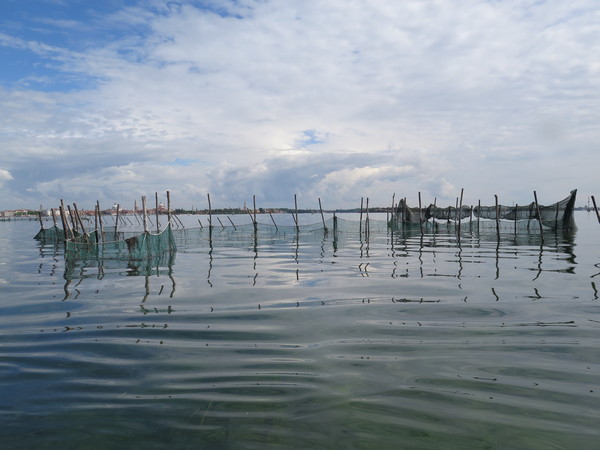There is a continuous exchange of tides and organisms between the lagoon and the sea. This exchange is fundamental, including for fishing: various fish, cephalopods and crustaceans migrate from the sea to the lagoon to breed and feed, exploiting the greater productivity of the transitional waters compared to the coastal waters.
Many marine breeding species, such as sea bream, sea bass, flounder, sole and mullet, which are important stocks exploited for fishing, are concentrated at the juvenile stage precisely in the shallow-water habitats of transitional environments.
In addition, there are the inlets, no longer simple corridors between the sea and the lagoon, but veritable habitats chosen by fish and marine organisms that love their characteristics, despite the overbuilding.
This is being discovered by ecologists and biologists who for years have been studying the organisms that live and move between the sea and the lagoon. They follow them by patrolling the inlets with the help of sound waves.
The first three surveys using a precision echo sounder carried out in the summer, autumn and winter of 2018 showed that it is not only possible to 'see' the passage of schools of fish, but even to recognize very small species.
This was possible thanks to the Exchange project, which has just come to an end, financed by the European Maritime and Fisheries Fund (EMFF 2014-2020).
“Each organism has its own 'imprint' that the precision echo sounder records and which we learn to recognize,” explains Fabio Pranovi, professor of Marine Ecology at the Department of Environmental Sciences, Informatics and Statistics at the Ca’ Foscari University of Venice and coordinator of the project. “Thanks to this active acoustics technique, used for the first time in the Venice lagoon, we were able to evaluate the flows of organisms through the inlets, including in relation to different environmental conditions (season, time of day, tide). The project enabled us to make an initial quantification of the exchanges of marine organisms through the Lido inlet and to highlight the relationship between flows and tidal conditions.”
The monitoring campaigns have also brought to light the fact that acoustic detection technologies, thanks in part to their speed, can be used as an early warning tool.
There is the emblematic case of the warty comb jelly or sea walnut (Mnemiopsis leidyi), which exploded, especially in summer, from 2016. This gelatinous-looking organism, mistaken for jellyfish, feeds on larvae and eggs. It is responsible for the slump in sardine fishing in the Black Sea in the 1980s.
In the lagoon, therefore, it is an alien species, harmless to humans, but capable of clogging fishermen's nets. Its presence, the researchers explain, follows deep and hard-to-predict fluctuations. The echo sounder did not detect its presence in the Lagoon in 2018, unlike what was reported just one year earlier.
“Given that it is a voracious predator of larval stages of many fish species of commercial interest,” explains Pranovi, “it is clear how organising periodic monitoring can be of significant value in management terms, activating, for example, potential measures to mitigate harmful effects, such as active harvesting campaigns using pelagic nets at the entrance to the inlets or the manual collection by fishermen of individuals that attach themselves to gillnets.”
Pranovi is coordinating the follow-up to these first campaigns, Exchange II, a project that intends to enhance the encouraging results of Exchange, extending the acoustic sampling to the Malamocco and Chioggia inlets too, to obtain an overview of the incoming and outgoing neectonic biomass flows to and from the Venice lagoon, and carrying out, in parallel with the acoustic measurements, sampling with traditional scientific fishing techniques to validate the data collected.
A third project will continue until June 2021, involving, as the title itself explains, the "Evaluation and improvement of the environmental sustainability of artisanal fishing in the Natura 2000 sites of the Venice lagoon". Coordinated by Professor Piero Franzoi, it aims to promote the environmental sustainability of artisanal fishing and protect biodiversity in the Venice lagoon.
The monitoring of the environmental characteristics, the shapes of the lagoon landscape and the catches using fixed nets (tresse with bertovelli), carried out in collaboration with professional fishermen, will enable the distribution of alien species (coming from other habitats) and plastic waste to be mapped, investigating the environmental factors most involved in their diffusion.
The project will also experiment modifications to fishing gear to encourage the release of protected species and increase the sensitivity of fishermen to the conservation of biodiversity.
“Studies of this kind are indispensable to achieve an overall view of the ecological workings of the lagoon-coastal area system,” concludes Franzoi, “significantly contributing to the implementation of a truly ecosystemic management approach










